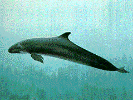
False killer whales live in tight pods that vary in size from fewer than 10 to more than 100 individuals. All ages and both sexes travel together. Jetting through the water with their black, torpedolike bodies, false killer whales can look menacing. Quick and agile, they execute high leaps and make rapid turns and sudden stops.
Much of this activity is associated with feeding. Although they eat primarily squid and large fish in deep offshore waters, false killer whales are opportunists and consume a wide variety of fish. Their adaptability is crucial, because in the tropical and warm temperate ocean where they live, food is not nearly as abundant as it is toward the poles. These dolphins have developed a bad reputation for stealing fish from fishermen's lines and have even been known to attack, and perhaps eat, dolphins escaping from tuna nets in the eastern tropical Pacific. There is one report of false killers attacking and killing a humpback whale calf in Hawaiian waters. Held responsible for depleting the fish populations around Japan, hundreds of false killer whales have been driven ashore there and slaughtered.
Pseudorca crassidens
Size: 4 to 5.5 m, 1,200 to 2,000 kg. Males slightly larger than
females
Calves at birth: 157 to 183 cm
Teeth: 8 to 11 large teeth on each side of upper and lower jaws
Food: Squid and large fish such as tuna. Sometimes attacks dolphins
escaping from tuna nets
Habitat: Deep offshore waters
Range: Tropical and warm temperate world ocean
Status: Population unknown
